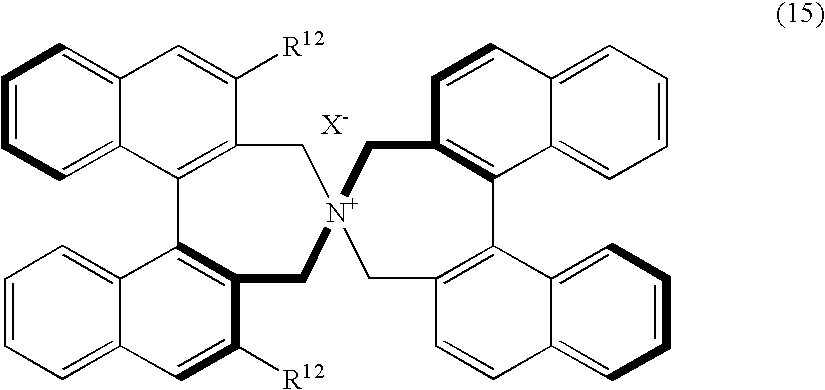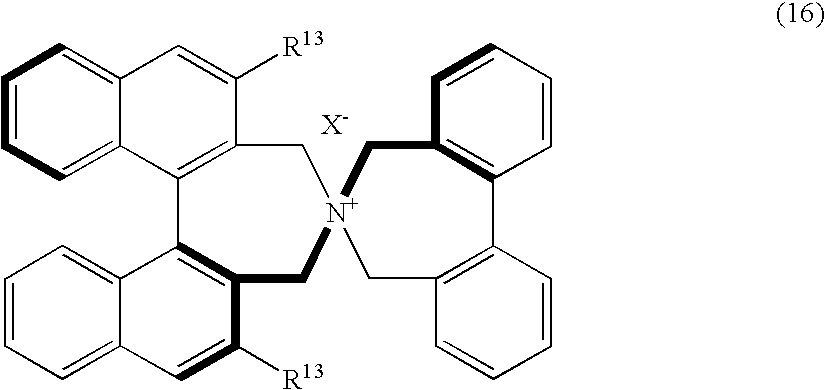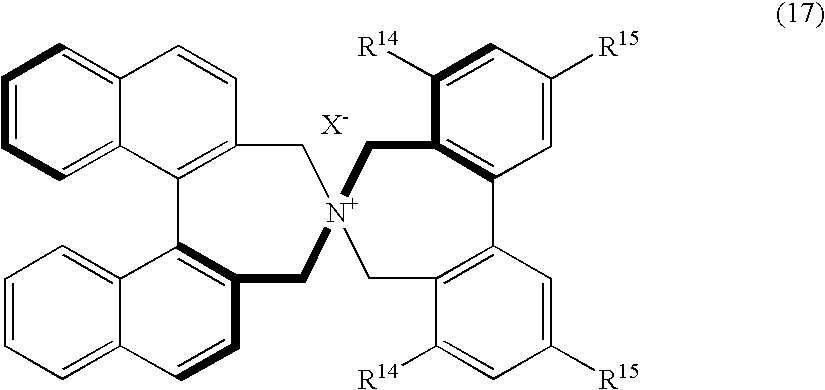Optically active quaternary ammonium salt, process for producing the same, and process for producing optically active alpha-amino acid derivative with the same
a technology of quaternary ammonium salt and optically active quaternary ammonium salt, which is applied in the direction of organic compounds/hydrides/coordination complex catalysts, physical/chemical process catalysts, organic chemistry, etc., can solve the problems of significant decrease in the selectivity of catalysts, reactive decrease of catalysts, and reduced selectivity toward some substrates, etc., to achieve high selectivity, high stereoselectivity, and high selectivity
- Summary
- Abstract
- Description
- Claims
- Application Information
AI Technical Summary
Benefits of technology
Problems solved by technology
Method used
Image
Examples
example 1
Synthesis of (R)-1,1′-bi-(4,6-dibromo-2-methoxymethoxy)naphthyl (2)
[0184]
[0185]In an argon atmosphere, 60% sodium hydride (0.880 g, 22 mmol) was added to a tetrahydrofuran solution (50 mL) of Compound 1 (6.02 g, 10 mmol) at 0° C. and the mixture was stirred for 10 minutes. Subsequently, chloromethyl ether (1.67 mL, 22 mmol) was added at 0° C., and the reaction mixture was allowed to warm to room temperature and was then stirred for 1 hour. After completion of the reaction, the reaction mixture was poured into water and was extracted with dichloromethane. The dichloromethane solution was dried over anhydrous sodium sulfate and was concentrated under reduced pressure. To the resulting white solid, hexane (30 mL) was added and the solution was filtered to give Compound 2 (6.90 g, 10 mmol) in a quantitative manner.
[0186]1H-NMR (400 MHz, CDCl3) σ 8.43 (2H, d, J=2.4 Hz, Ar—H), 7.94 (2H, s, Ar—H), 7.33 (2H, dd, J=2.4 Hz, 9.2 Hz, Ar—H), 6.96 (2H, d, J=9.2 Hz, Ar—H), 5.07 (2H, d, J=7.2 Hz, A...
examples 2 through 6
Synthesis of (R)-1,1′-bi-{4,6-bis(trialkylsilyl)-2-methoxymethoxy}naphthyls (3a through 3e)
[0187]
[0188]In an argon atmosphere, a 1.40M tert-butyllithium solution (1.93 mL, 2.7 mmol) was added dropwise to a tetrahydrofuran solution (10 mL) of Compound 2 (0.207 g, 0.30 mmol) at −78° C., and the mixture was stirred for 15 minutes. Subsequently, a corresponding trialkylchlorosilane (1.80 mmol) was added at −78° C., and the reaction mixture was allowed to warm to room temperature and was then stirred for 4 hours. After completion of the reaction, the reaction mixture was poured into water and was extracted with dichloromethane. The dichloromethane solution was dried over anhydrous sodium sulfate and was concentrated under reduced pressure. The resulting residue was subjected to a silica gel column chromatography and eluted with a mixed solvent of diethylether / hexane to give Compounds 3a through 3e in yields of 60 to 85%.
[0189]Chemical data for the products of Examples 2 through 6 are sho...
example 3 (
Product of Example 3 (Compound 3b)
[0191](R)-1,1′-bi-{4,6-bis(triethylsilyl)-2-methoxymethoxy}naphthyl: 1H-NMR (400 MHz, CDCl3) σ 8.24 (2H, s, Ar—H), 7.67 (2H, s, Ar—H), 7.31 (2H, dd, J=1.2 Hz, 8.4 Hz, Ar—H), 7.19 (2H, d, J=8.4 Hz, Ar—H), 5.04 (2H, d, J=6.4 Hz, Ar—OCH2), 4.91 (2H, d, J=6.4 Hz, Ar—OCH2), 2.97 (6H, s, OCH3), 1.40-0.80 (60H, m, SiCH2CH3).
PUM
| Property | Measurement | Unit |
|---|---|---|
| temperature | aaaaa | aaaaa |
| temperature | aaaaa | aaaaa |
| temperature | aaaaa | aaaaa |
Abstract
Description
Claims
Application Information
 Login to View More
Login to View More - R&D
- Intellectual Property
- Life Sciences
- Materials
- Tech Scout
- Unparalleled Data Quality
- Higher Quality Content
- 60% Fewer Hallucinations
Browse by: Latest US Patents, China's latest patents, Technical Efficacy Thesaurus, Application Domain, Technology Topic, Popular Technical Reports.
© 2025 PatSnap. All rights reserved.Legal|Privacy policy|Modern Slavery Act Transparency Statement|Sitemap|About US| Contact US: help@patsnap.com



